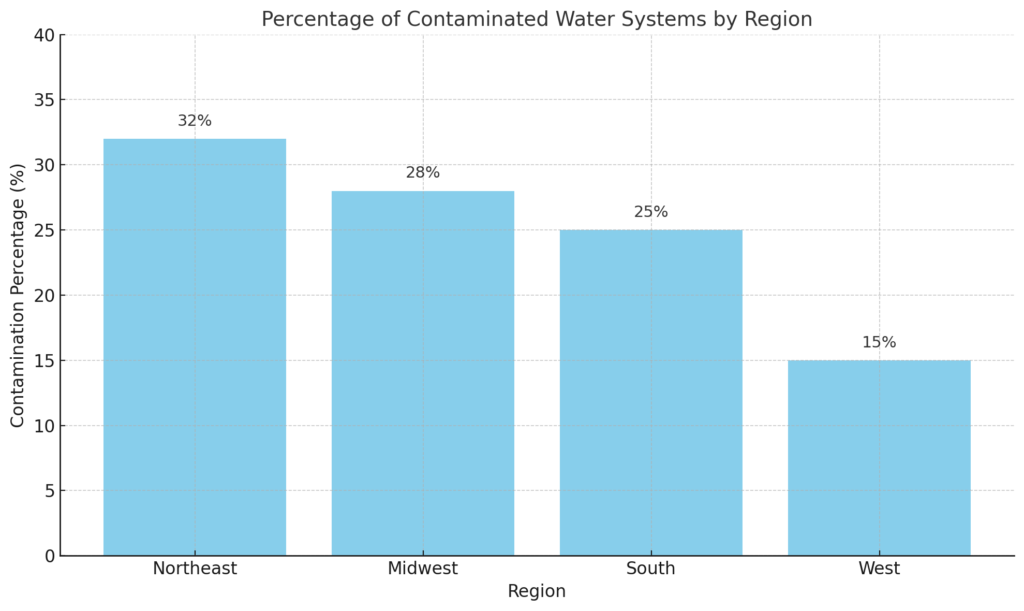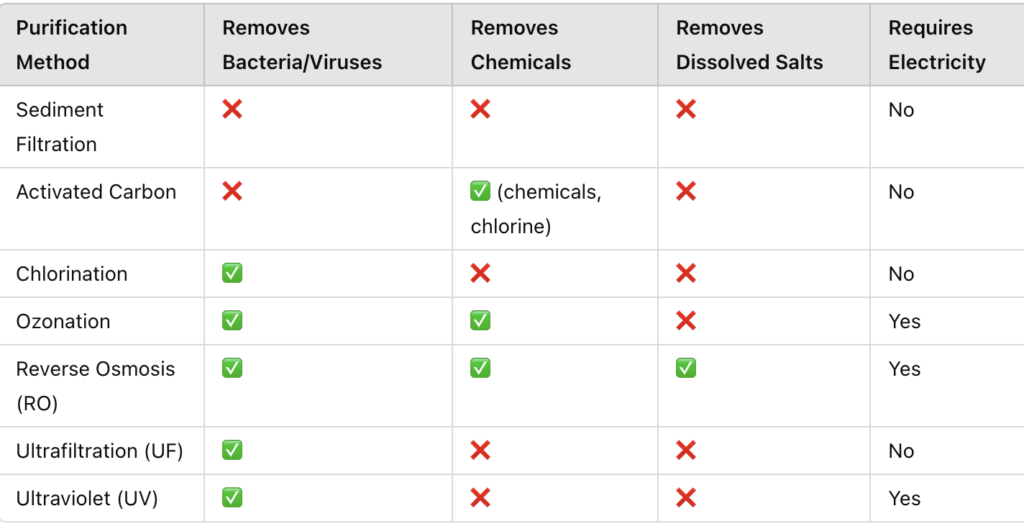Real-World Implications

Water is the foundation of life, yet access to clean and safe drinking water remains one of humanity’s most pressing challenges. While Earth’s surface is covered in water, less than 1% is readily available as freshwater, and even this fraction is often contaminated with pollutants ranging from bacteria and viruses to heavy metals, industrial chemicals, and microplastics. These contaminants can cause severe health issues, including gastrointestinal infections, neurological damage, and developmental disorders in children.
The importance of water purification extends beyond individual health. It plays a crucial role in public sanitation, environmental sustainability, and even global stability. In areas where clean water is scarce, conflicts over water rights emerge, affecting entire communities. The Flint water crisis in the United States (2014–2019) is a stark example of how failing infrastructure and inadequate purification can lead to widespread lead poisoning, disproportionately affecting marginalized communities. Meanwhile, in developing nations, diseases like cholera and dysentery remain leading causes of death due to the lack of access to safe drinking water.
Historically, civilizations have recognized the need for clean water. The ancient Egyptians purified water using coagulants like alum, while the Greeks and Romans developed rudimentary sand filters and even aqueduct systems to transport relatively clean water. However, it was not until the 19th century, with the discovery of waterborne diseases and the germ theory, that modern water purification methods like chlorination became widespread.
Today, advancements in filtration, chemical treatment, and membrane technologies ensure safer drinking water for millions. This guide explores the science behind water purification, the technologies available, and their real-world applications. By understanding these principles, individuals and communities can make informed choices that not only protect health but also contribute to environmental sustainability.

1. Understanding Water Contaminants
Water is rarely pure in its natural state. As it moves through the environment, it picks up various contaminants, classified into four main categories: physical impurities, biological contaminants, chemical pollutants, and dissolved salts and minerals. Each type requires different purification techniques.
1.1 Physical Impurities: The First Line of Contamination
Physical impurities include dirt, sand, rust, and sediment. These contaminants do not pose immediate health risks but can make water unpleasant to drink and clog plumbing systems.
In ancient times, people used settling methods to remove these impurities—allowing water to sit so heavier particles would sink to the bottom. Cloth straining, an early form of filtration, was practiced in India and Egypt over 3,000 years ago. Modern sediment filtration builds upon these principles using fine mesh screens and ceramic filters to trap larger particles while allowing water to pass through.

1.2 Biological Contaminants: The Silent Killers
Microbial pathogens, including bacteria, viruses, and protozoa, are among the most dangerous contaminants. Diseases like cholera, typhoid, and hepatitis A are directly linked to contaminated water.
- Historical Example: In 1854, the Broad Street cholera outbreak in London led physician John Snow to trace the disease to a contaminated water pump. This was a pivotal moment in public health, emphasizing the need for water sanitation.
- Modern Example: In 2010, Haiti experienced a deadly cholera outbreak caused by contaminated river water. Over 10,000 people died, highlighting the ongoing need for effective water treatment in disaster-stricken areas.
Chlorination, ozonation, and ultraviolet (UV) purification are the most effective methods for eliminating biological contaminants. Each has distinct advantages—chlorine is widely used for municipal water, ozone is a powerful disinfectant with no residual taste, and UV purification provides chemical-free sterilization.
1.3 Chemical Contaminants: The Hidden Threat
Chemical pollutants are insidious because they often go unnoticed. These include:
- Heavy metals (lead, arsenic, mercury) from industrial waste, old pipes, and mining activities.
- Pesticides and fertilizers from agricultural runoff, leading to nitrate contamination that can cause “blue baby syndrome” in infants.
- Pharmaceutical residues, including antibiotics and hormones, which disrupt aquatic ecosystems and may contribute to antibiotic resistance.
The 20th century saw major improvements in chemical filtration. In Japan, after the Minamata disaster (1950s), where mercury poisoning devastated coastal communities, stricter water safety regulations led to the widespread adoption of activated carbon filtration and reverse osmosis (RO) systems. Today, carbon filtration remains a key technology for removing organic chemicals and improving taste and odor.
1.4 Dissolved Salts and Minerals: The Balance Between Health and Hardness
While some dissolved minerals like calcium and magnesium are beneficial, excessive amounts can cause hard water, leading to scale buildup in pipes and reducing soap effectiveness. High sodium or fluoride levels, common in some groundwater sources, can cause health issues over time.
Desalination plants, which use RO technology, have become critical in arid regions like the Middle East, where freshwater sources are scarce. Countries like Israel and Saudi Arabia rely on large-scale RO plants to convert seawater into drinking water, demonstrating the importance of advanced purification in water-scarce regions.
2. Water Purification Technologies: The Science of Clean Water
Water purification technologies have evolved significantly, from simple boiling techniques used by ancient civilizations to sophisticated multi-stage filtration systems found in modern homes and industries.
2.1 Filtration Methods: Trapping the Undesirable
Sediment Filtration: The First Defense
Sediment filters use mechanical barriers to trap dirt, rust, and sand. These filters are commonly found in household water purifiers as a pre-filtration step.
🔍 Analogy: A coffee filter prevents coffee grounds from reaching your cup—similarly, a sediment filter blocks larger particles but does not remove microscopic contaminants.
Activated Carbon Filtration: The Chemical Sponge
Activated carbon absorbs chlorine, pesticides, and organic chemicals, improving water taste and odor.
🔍 Real-World Impact: In the aftermath of Hurricane Katrina (2005), activated carbon filters were used in emergency response efforts to remove chemical contaminants from floodwater sources.
2.2 Chemical Treatment: The Power of Disinfection
Chlorination: A Double-Edged Sword
Chlorine effectively kills pathogens but can form harmful byproducts like trihalomethanes (THMs). Despite its drawbacks, it remains the most common method for municipal water treatment worldwide.
🔍 Comparison: Chlorine is like a flame—it burns pathogens but can also cause unintended damage if not carefully managed.
Ozonation: The Future of Disinfection
Ozone (O₃) is more powerful than chlorine and leaves no chemical residue. However, it requires electricity, making it less practical for rural areas.
🔍 Historical Shift: European cities like Paris adopted ozonation over chlorination due to concerns over chlorine byproducts, setting a precedent for cleaner municipal water treatment.
2.3 Advanced Purification: The Cutting Edge
Reverse Osmosis (RO): The Gold Standard
RO membranes filter out dissolved salts, heavy metals, and even microplastics. While highly effective, RO systems waste significant amounts of water.
🔍 Innovation: In Singapore, NEWater, an advanced RO-based purification program, recycles wastewater into drinkable water, providing a sustainable solution for water scarcity.
Ultraviolet (UV) Purification: Nature’s Sterilizer
UV light disrupts microbial DNA, rendering bacteria and viruses harmless.
🔍 Application: NASA employs UV purification in space missions to ensure astronauts have access to safe drinking water aboard the International Space Station.
The Future of Water Purification
With increasing population growth, climate change, and pollution, water purification will remain a critical global issue. Innovations in nanotechnology filtration, smart water purifiers with IoT integration, and solar-powered desalination promise more efficient and sustainable solutions. From high-tech cities to remote villages, ensuring clean water access is not just a scientific challenge—it is a moral and humanitarian responsibility that shapes the future of global health and environmental stability.
